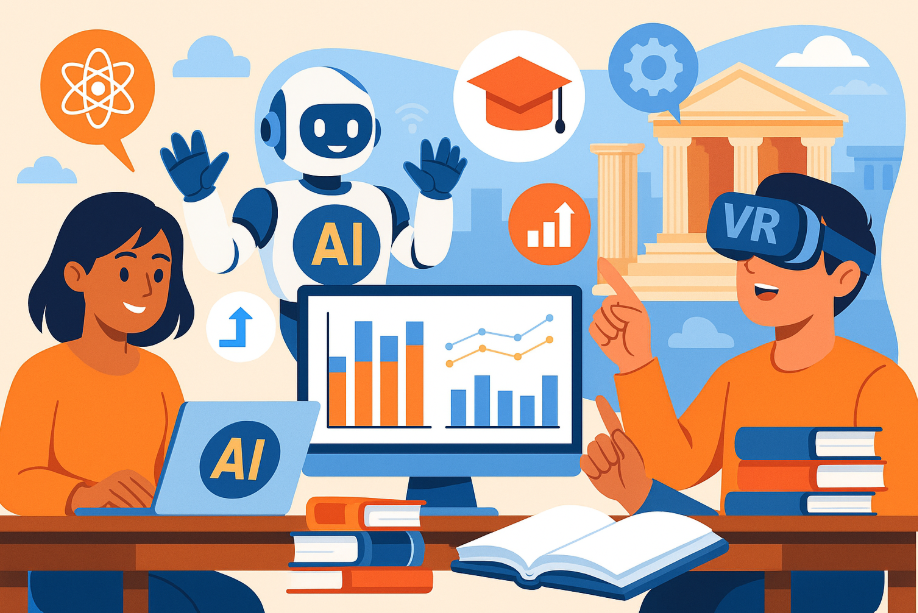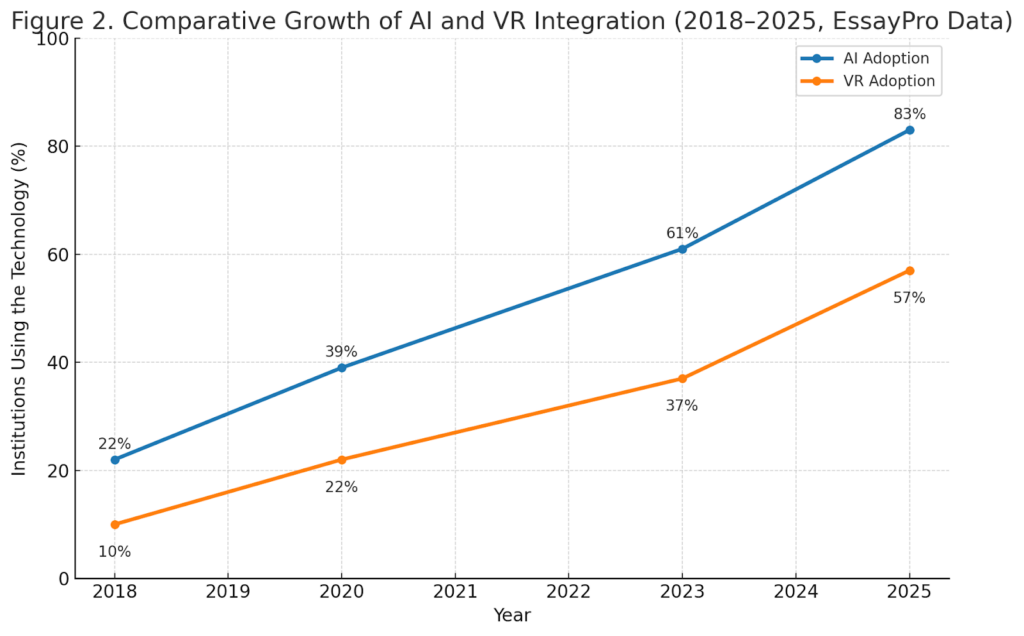
The past decade has seen education undergo an unprecedented digital transformation. Tools once reserved for science fiction – Artificial Intelligence (AI) and Virtual Reality (VR) – now define modern learning environments. From automated tutoring to immersive field simulations, these technologies reshape how students study, collaborate, and imagine knowledge itself.
According to EssayPro’s 2025 Global EdTech Research, 83% of universities and 68% of secondary schools worldwide now use AI or VR tools in some form. Together, these technologies are revolutionizing education by enhancing interactivity, personalizing instruction, and bridging geographic gaps.
The Rise of AI and VR in Education
Education has always evolved alongside technology – from chalkboards to cloud platforms. But AI and VR represent not just new tools, but new dimensions of learning. AI in education statistics show that machine learning systems now support grading, feedback, and curriculum planning, while VR for students brings experiential learning into the digital space.
A global study by EssayPro (2025) found that 71% of educators believe these tools have improved student engagement, and 64% report better comprehension rates among students exposed to AI or VR lessons.
Table 1. Global AI and VR Usage in Education (EssayPro 2025 Study)
| Education Level | % Using AI Tools | % Using VR Tools |
| Primary | 52% | 28% |
| Secondary | 68% | 42% |
| University | 83% | 57% |
Insight: These figures indicate strong growth across all academic levels, though universities lead in integrating both technologies.
AI in Education – Current Adoption Statistics
AI is redefining teaching by automating administrative work and personalizing learning. According to statistics on AI adoption in education, 58% of schools in developed countries use AI-driven systems for at least one academic function. Common examples include:
- Automated grading systems for quizzes and short essays.
- Adaptive learning software that adjusts to student progress.
- Chatbots that answer student queries 24/7.
- Predictive analytics to identify at-risk students early.
Incorporating AI tools can lighten workloads and free instructors to focus on mentorship. However, not all educators have equal access. EssayPro’s 2025 Report found that 31% of institutions lack the infrastructure to fully deploy AI technologies.
For students balancing innovation and academic writing, platforms such as essay writing service can supplement learning. These services help refine writing and analytical skills – valuable when interpreting AI feedback or constructing data-based reports.
Figure 1. Growth of AI Tool Adoption in Higher Education (2018-2025, EssayPro Study)
- 2018: 22%
- 2020: 39%
- 2023: 61%
- 2025: 83%

The data highlights exponential growth, showing how quickly AI has shifted from pilot programs to essential classroom infrastructure.
VR in Education – Adoption and Usage Trends
While AI focuses on automation, VR focuses on immersion. The VR in education statistics show that virtual environments help students visualize abstract concepts, conduct simulations, and collaborate across continents.
EssayPro’s 2025 EdTech Adoption Report revealed that 57% of universities use VR applications in at least one department – especially in STEM, medical training, and history programs.
Table 2. Global VR Adoption by Discipline (EssayPro 2025 Data)
| Academic Discipline | % Using VR Tools |
| Medicine | 72% |
| Engineering | 64% |
| History | 48% |
| Education | 33% |
| Business | 26% |
The data reflect how virtual reality education is particularly effective in fields requiring visualization or spatial awareness. For instance, medical students perform VR surgeries before operating on real patients, reducing human error.
Example: In EssayPro’s survey, 89% of medical students reported improved retention of anatomical structures after VR-based training compared to traditional textbook study.
Comparative Analysis – AI vs. VR in Classrooms
Although both technologies transform learning, they serve different purposes. AI enhances personalization and efficiency, while VR enriches engagement and context.
Figure 2. Comparative Growth of AI and VR Integration (2018-2025, EssayPro Data)
- AI adoption growth: +61%
- VR adoption growth: +46%

These findings indicate that AI tools are growing slightly faster, primarily because they require less hardware investment than VR.
However, the AI and VR integration in education movement is gaining speed – with 39% of institutions now combining both. For example, some schools use AI to adapt VR environments in real time, personalizing learning experiences for each student.
Benefits and Challenges of AI and VR Integration
Key Benefits
- Personalized Learning: AI tailors lesson difficulty and pacing.
- Immersive Understanding: VR recreates real-world environments for deeper engagement.
- Accessibility: Virtual classrooms expand education beyond physical borders.
- Skill Development: Gamified VR systems boost motivation and cognitive retention.
Key Challenges
- Cost: Hardware and licensing fees remain prohibitive for smaller institutions.
- Ethics and Data Privacy: Storing student data on AI systems raises concerns.
- Training Gaps: Only 42% of teachers report receiving formal training on AI or VR tools.
- Digital Divide: Infrastructure inequality leaves underfunded schools behind.
Despite these obstacles, EssayPro’s Global Tech Education Survey predicts that AI and VR integration in education will become mainstream by 2030.
Future Outlook – Educational Technology Beyond 2025
The future of EdTech looks promising. According to statistics on VR adoption in education, usage is projected to reach 71% of universities and 54% of high schools by 2028. Meanwhile, AI in education statistics forecast near-universal adoption, reaching 92% of schools globally by 2030.
List: Emerging Trends in Educational Technology (EssayPro 2025 Forecast)
- AI tutors for 24/7 personalized support.
- Hybrid classrooms blending VR and physical labs.
- Neuroadaptive learning, adjusting in real time to cognitive states.
- Data ethics frameworks to protect student information.
As both tools evolve, education will increasingly rely on data-driven insights and immersive environments – redefining what it means to teach and learn.
Essay Writing and Academic Innovation
AI and VR are not just reshaping how students learn, but also how they express understanding. Many institutions now require essays reflecting on technological experiences. In EssayPro’s 2025 Writing Research, 67% of students said writing essays about technology improved their ability to analyze and communicate complex ideas.
Students often turn to essay writing service resources to model academic writing, understand citation rules, and practice critical evaluation – essential skills when discussing AI and VR technologies. Writing about immersive learning itself strengthens comprehension of its psychological and ethical dimensions.
FAQs
Q1: How widely are AI tools used in education today?
AI is used in roughly 83% of universities and 58% of schools, primarily for grading, analytics, and tutoring systems.
Q2: What percentage of schools have adopted VR learning tools?
Globally, 57% of universities and 42% of secondary schools use VR-based education platforms.
Q3: Which is more effective for students: AI or VR?
Effectiveness depends on context. AI enhances personalization, while VR improves experiential learning. Studies suggest combining both yields the best results.
Q4: What are the biggest challenges in adopting emerging technologies in classrooms?
High costs, lack of infrastructure, limited teacher training, and ethical data use are the primary barriers to adoption.
Conclusion
AI and VR are no longer futuristic – they are foundational to modern education. The statistics on AI adoption in education and statistics on VR adoption in education demonstrate rapid growth, especially in universities leading digital transformation.
The relationship between technology and learning outcomes is clear: well-implemented systems enhance engagement, retention, and accessibility. As educators continue to explore these innovations, platforms like EssayPro’s essay writing service support the academic side – helping students refine critical writing skills while navigating new frontiers of digital learning.
By 2030, AI and VR will be fully integrated into everyday classrooms, shaping not only how knowledge is taught but also how it is experienced.
References
OECD. Education and Digital Transformation Report 2024. https://www.oecd.org/education
UNESCO. The Future of Learning 2025. https://unesdoc.unesco.org
ScienceDirect. AI and VR in Education Research. https://www.sciencedirect.com
TEM Journal. Technological Trends in Learning 2025. https://www.temjournal.com

